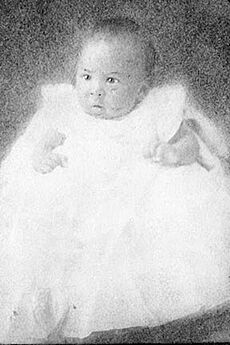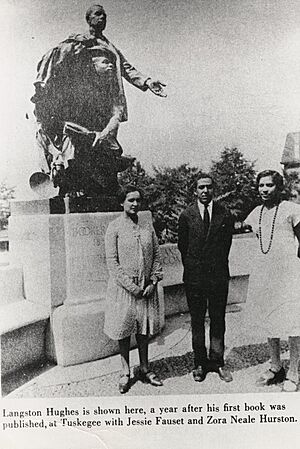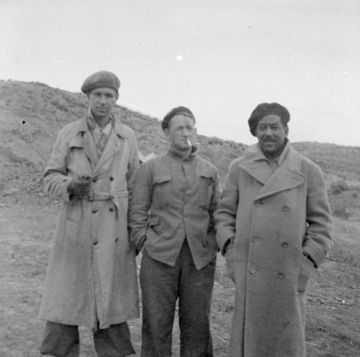Langston Hughes facts for kids
Quick facts for kids
Langston Hughes
|
|
|---|---|
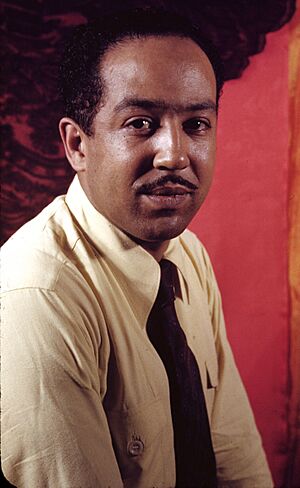
Portrait by Carl Van Vechten, 1942
|
|
| Born | James Mercer Langston Hughes February 1, 1901 Joplin, Missouri, U.S. |
| Died | May 22, 1967 (aged 66) New York City, U.S. |
| Occupation |
|
| Education | |
| Period | 1926–1964 |
| Relatives |
|
Langston Hughes (born February 1, 1901, died May 22, 1967) was an important American writer. He was a poet, novelist, and playwright from Joplin, Missouri. He is famous for his role in the Harlem Renaissance. This was a time when Black artists, writers, and musicians created amazing works. Hughes was also one of the first to write jazz poetry. This style mixes poetry with the rhythms of jazz music.
He grew up in the Midwest and started writing a lot when he was young. Later, he moved to New York City and became a well-known writer. He studied at Columbia University for a while. Even though he left, his writing caught the attention of publishers. His first book of poems, The Weary Blues, came out in 1926. He later graduated from Lincoln University.
Besides poetry, Hughes wrote many plays, short stories, and novels. He also wrote a weekly newspaper column for The Chicago Defender from 1942 to 1962. This was during the civil rights movement. His column shared important ideas about equality and justice.
Contents
His Early Life and Family
Langston Hughes had a diverse family background. Some of his ancestors were Black people who had been enslaved. Others were white landowners. His maternal grandmother, Mary Patterson, was a very educated woman. She was one of the first women to attend Oberlin College. She later married Charles Henry Langston. Charles and his brother, John Mercer Langston, were important activists. They worked to end slavery and fought for the rights of Black Americans.
Charles Langston and his family moved to Kansas. There, he continued to work as an educator and activist. His daughter, Carrie, became a schoolteacher. Carrie was Langston Hughes's mother. Langston was born in Joplin, Missouri, in 1901.
Langston's father left the family when Langston was very young. His father moved to Cuba and Mexico. He wanted to escape the unfair treatment Black people faced in the United States. Langston's mother traveled to find work. So, Langston was mostly raised by his grandmother, Mary Patterson Langston, in Lawrence, Kansas.
His grandmother taught him to be proud of his heritage. She shared stories of her generation's fight for justice. This made a big impact on Langston. He felt it was his duty to help Black people who were struggling. He wrote about their lives in his work.
In his book The Big Sea, Hughes wrote about feeling lonely as a child. He found comfort and wonder in books. After his grandmother passed away, he lived with family friends. Later, he lived with his mother again in Lincoln, Illinois. The family then moved to Cleveland, Ohio. He went to Central High School there. His teacher, Helen Maria Chesnutt, inspired him greatly.
School Days and First Poems
Langston started writing when he was young. In grammar school, he was chosen as the class poet. He later thought this happened because of a common idea that Black people naturally had a good sense of rhythm.
He wrote for his high school newspaper and edited the yearbook. He also started writing his own short stories, poems, and plays. One of his first jazz poetry pieces, "When Sue Wears Red," was written during this time.
College and Early Travels
Langston Hughes had a difficult relationship with his father. His father wanted him to study engineering, not writing. They made a deal: Langston would go to Columbia University to study engineering, but he could also write. His father paid for his tuition.
At Columbia, Hughes did well in his classes. He even published poems in the school newspaper. But he faced unfair treatment because he was Black. He was denied a dorm room on campus. He found more comfort in the vibrant Black community of Harlem than in his studies. Harlem was full of exciting cultural life. He decided to leave Columbia in 1922 to focus on his writing.
Hughes took on many different jobs. In 1923, he worked as a crewman on a ship. This allowed him to travel to West Africa and Europe for six months. He spent some time in Paris, France. Later, he returned to the U.S. and lived with his mother in Washington, D.C.. He worked as a personal assistant to historian Carter G. Woodson. But this job left little time for writing. So, he quit and worked as a busboy at a hotel.
One day, he met the famous poet Vachel Lindsay. Hughes shared some of his poems with Lindsay. Lindsay was very impressed and helped spread the word about this talented new Black poet.
In 1926, Hughes enrolled in Lincoln University. This was a historically Black university in Pennsylvania. He earned his college degree in 1929. After graduating, he moved back to New York City. Harlem became his main home for the rest of his life. He continued to travel, visiting places like the Soviet Union and the Caribbean.
A Writer's Journey
Hughes's famous poem, "The Negro Speaks of Rivers," was first published in 1921. It appeared in The Crisis magazine. This magazine was from the National Association for the Advancement of Colored People (NAACP). The poem was later included in his first book of poetry, The Weary Blues, in 1926.
Hughes was a very important figure during the Harlem Renaissance in the 1920s. He worked alongside other great writers like Zora Neale Hurston and Aaron Douglas. They wanted to show the real lives of ordinary Black people in their art. They also spoke out against unfair treatment within the Black community.
In 1926, Hughes wrote an important essay called "The Negro Artist and the Racial Mountain." In it, he said:
The younger Black artists who create now want to express themselves without fear or shame. If others like it, that's great. If not, it doesn't matter. We know we are beautiful. And sometimes, we are also sad or struggling. We build our future, strong as we know how. We stand free within ourselves.
Exploring the American South
In 1927, Hughes traveled to the Southern U.S. He visited places like Nashville, Tennessee and Texas. He wanted to learn more about the lives and folk culture of Black people there. He saw firsthand the challenges and unfair treatment they faced. He also experienced racism himself during this trip.
During his travels, he met another famous writer, Zora Neale Hurston, in Mobile, Alabama. They decided to travel together. They collected folk songs and stories from Black communities in the South.
They visited Tuskegee University and met writer Jessie R. Fauset. Hughes was asked to write a poem for Tuskegee University. This poem, "Alabama Earth," was published in 1928. They also met the famous singer Bessie Smith. The stories and songs Hughes collected helped him write his novel Not Without Laughter (1930). They also inspired a play he wrote with Hurston called Mule Bone.
This trip deeply changed Hughes's understanding of the South. It helped him grow as a writer and a person.
His Important Ideas and Works
Hughes's writing showed the lives of working-class Black Americans. He wrote about their struggles, joys, laughter, and music. His work always showed pride in Black identity and culture. He once said his goal was "to explain and illuminate the Negro condition in America." He challenged stereotypes and spoke out against unfair social conditions. He was a "people's poet" who wanted to inspire both artists and their audiences.
The night is beautiful,
So the faces of my people.
The stars are beautiful,
So the eyes of my people
Beautiful, also, is the sun.
Beautiful, also, are the souls of my people.
Hughes believed in cultural unity. He wanted people of African descent around the world to be proud of their heritage. His ideas influenced many Black writers in other countries. His work helped inspire the Négritude movement in France. This movement encouraged Black people to celebrate their identity. Hughes also used folk and jazz rhythms in his poetry. This made his poems unique and powerful.
In 1930, his first novel, Not Without Laughter, won an award. This book tells the story of a boy named Sandy. His family faces many challenges because of their race and social class.
Hughes continued to write many different kinds of works. He wrote short stories, plays, and even screenplays for films. He founded a theater group in Chicago called The Skyloft Players in 1941. This group aimed to support Black playwrights. He also wrote a popular column for The Chicago Defender newspaper for twenty years. In this column, he created a character named Jesse B. Semple, or "Simple." Simple was an everyday Black man in Harlem who shared his thoughts on current events.
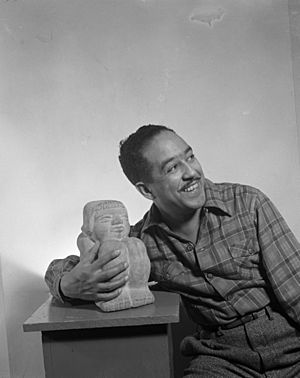
Hughes wrote novels, short stories, plays, poetry, operas, essays, and books for children. He also wrote two autobiographies, The Big Sea and I Wonder as I Wander. He helped other writers by giving advice and introducing them to important people. Many young Black writers, like Alice Walker, looked up to him. They saw him as a hero and an example.
Standing Up for What's Right
Langston Hughes strongly believed in equality and justice for all people. He was especially concerned about the unfair treatment of Black Americans. He explored different ideas and movements that promised a more equal society.
In 1932, Hughes traveled to the Soviet Union with a group of Black Americans. They were invited to work on a film about the lives of Black people in the U.S. The film was never made. However, Hughes got to travel widely through the Soviet Union and other countries like China, Japan, and Korea.
Hughes used his writing to support important causes. He wrote poems for newspapers that supported workers' rights and racial equality. In 1937, he traveled to Spain during the Spanish Civil War. He reported on the war for Black American newspapers. He also wrote a poem called Madrid about his experiences.
During World War II, Hughes initially questioned why Black Americans should fight for a country that treated them unfairly at home. However, he later supported the war effort. He believed that fighting for freedom abroad would also help the fight for civil rights in the U.S. He supported the "Double V campaign." This meant victory over enemies abroad and victory over racial discrimination at home.
Because of his strong beliefs and his involvement in certain groups, Hughes faced questions about his political views. In 1953, he was called to speak before a government committee. He explained that his interest in politics came from his personal need to understand and address the problems of unfairness. He said he was not deeply involved in any specific political party. After this, he focused more on poems about everyday life and feelings.
His Final Years and Legacy
Langston Hughes passed away on May 22, 1967, in New York City. He was 66 years old. His ashes are buried in the Schomburg Center for Research in Black Culture in Harlem. There is a special floor design there called Rivers. It is named after his famous poem, "The Negro Speaks of Rivers." This design reminds everyone of his deep connection to his heritage.
Langston Hughes in Arts and Media
Langston Hughes's work has inspired many other artists. He recorded his own poetry on an album called Weary Blues in 1959. Musicians like Charles Mingus created music to go with his words. He also wrote lyrics for other musical works.
His poems have been turned into songs by composers like Harry Burleigh. His life story has been told in films and plays. For example, the film Salvation (2003) showed Hughes as a teenager. The documentary Hughes' Dream Harlem explores his writings and the world he lived in.
His work Ask Your Mama: 12 Moods for Jazz was performed for the first time in 2009 at Carnegie Hall. This special performance celebrated Black American culture. In 2015, a multimedia concert called "The Langston Hughes Project" premiered in London.
In 2016, his powerful poem "I, Too" was printed in The New York Times. This showed how his words still speak to important events today.
Where to Find His Work
Many important libraries keep Langston Hughes's writings and personal items. The Beinecke Rare Book & Manuscript Library at Yale University has a large collection of his letters, manuscripts, and photographs. The Langston Hughes Memorial Library at Lincoln University also has many of his works. These places help us learn more about his life and contributions.
Awards and Tributes
Langston Hughes received many awards during his lifetime.
- In 1926, he won the Witter Bynner Poetry Prize.
- He received a Guggenheim Fellowship in 1935. This allowed him to travel and write.
- In 1943, Lincoln University gave him an honorary degree.
- The NAACP awarded him the Spingarn Medal in 1960. This was for his outstanding achievements as an African American.
After his death, many places and organizations honored him.
- The City College of New York created the Langston Hughes Medal in 1978.
- Schools like Langston Hughes Middle School in Virginia and Langston Hughes High School in Georgia are named after him.
- His home in Harlem, New York City, became a landmark in 1981. The street was renamed "Langston Hughes Place."
- In 2002, the U.S. Postal Service put his image on a postage stamp.
- He was inducted into the Chicago Literary Hall of Fame in 2012.
- In 2015, Google Doodle celebrated his birthday.
Published Works
Poetry Collections
Novels and Short Story Collections
|
Non-Fiction Books
Major Plays
Books for Children
As Editor
|
Related pages
Images for kids
-
Langston Hughes, 1943. Photo by Gordon Parks
-
The poem "Danse Africaine" as wall poem on a wall of the building at the Nieuwe Rijn 46, Leiden (Netherlands)
See also
 In Spanish: Langston Hughes para niños
In Spanish: Langston Hughes para niños
- African-American literature
- Langston Hughes Society
- Pan-Africanism


